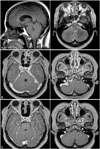Dear Editor,
Immunoglobulin G4-related disease (IgG4-RD) is a recently recognized clinical entity characterized by elevated serum IgG4 and infiltration of IgG4-positive plasma cells leading to organ swelling or sclerosis.1 IgG4-RD may affect various organs, more commonly the orbit or pituitary gland than the nervous system. However, due to increasing reports on meningeal inflammation associated with elevated serum IgG4, IgG4-related hypertrophic pachymeningitis (IgG4-HP) has become an important manifestation of IgG4-RD.2 Herein we report a case of IgG4-HP involving the posterior fossa, which initially mimicked Chiari malformation.
A 43-year-old woman presented with progressive headache, dizziness, and unsteadiness that had first appeared several months previously. The headache mostly developed in the right occipital area, and tended to increase when she stood upright. A neurologic examination showed mild rightward veering on tandem gait and bilateral limb dysmetria. Brain MRI without a contrast agent revealed a cerebellar tonsillar herniation at 5 mm below the foramen magnum, which was consistent with Chiari malformation type I (Fig. 1A). However, over the following 5 months her headache worsened and migrated into the right temporal area. She developed transient visual loss with severe headache involving the whole cranium, and left hemifacial neuralgic pain. A neurologic examination revealed left beating spontaneous nystagmus without visual fixation, impaired leftward smooth pursuit, and hypesthesia on the left side of her face.
Fundus photography showed a normal disc in both eyes but abnormal extorsion of the right eye (14.6°). Audiometry revealed sensorineural hearing loss in the right ear, and no brainstem auditory evoked potential was elicited during stimulation of the right ear. Bithermal caloric tests showed 46% right canal paresis. MRI with gadolinium enhancement disclosed diffusely thickened dura mater and well-enhanced multifocal nodular lesions involving the right parasellar area, bilateral tentorium, posterior fossa, and foramen magnum (Fig. 1B). These findings were compatible with hypertrophic pachymeningitis leading to secondary cerebellar tonsillar herniation and mild hydrocephalus. Her serum IgG4 was elevated at 176 mg/dL (normal range: 4.8-105 mg/dL). Autoimmune markers including antineutrophil cytoplasmic antibody and angiotensin-converting enzyme were negative. Her hemifacial pain immediately resolved after administering methylprednisolone, and her headache and dizziness gradually improved on a maintenance dosage of oral prednisolone. Brain MRI performed 3 months later revealed a marked improvement of the meningeal thickening along with disappearance of the nodular lesions (Fig. 1C).
Hypertrophic pachymeningitis may be a manifestation of various conditions such as neurosyphilis, granulomatosis with polyangiitis, neurosarcoidosis, or dural carcinomatosis.3 Thus, confirmation of histological features including lymphoplasmacytic infiltration, storiform fibrosis, and obliterative phlebitis is required for a definitive diagnosis of IgG4-HP.123 Although a pathological study was not performed, our patient met the criteria for a possible diagnosis of IgG4-RD, with distinctive mass-forming lesions along the dura mater and a serum IgG4 concentration of >135 mg/dL.1 Most pathologically proven cases of IgG4-HP have involved the spinal cord or the supratentorial areas including the orbital region.2 Several studies have found posterior fossa involvements,45 but no previous study has revealed cerebellar herniation in association with IgG4-HP. The symptoms and signs of IgG4-HP reflect mechanical compression of vascular or neural structures that lead to functional deficits. The nodular lesion compressing the left pontine tegmentum may explain the left hemifacial pain reported by our patient, and another lesion compressing the right internal acoustic meatus may have caused the audiovestibulopathy. In addition, diffuse pachymeningeal enlargements and multifocal nodular lesions occupying the posterior fossa resulted in crowding of the neural structures and a downward displacement of the cerebellar tonsil below the foramen magnum. Although the mechanism underlying Chiari malformation remains to be elucidated, anatomical variations including abnormal bone thickening have been proposed as factors responsible for a crowded posterior fossa and the resultant downward herniation of the cerebellar tonsil.6 When a patient with cerebellar tonsillar ectopia shows a rather rapid clinical decline or lateralized manifestation such as trigeminal neuralgia, the presence of space-occupying lesions including IgG4-HP should be considered.
Figures and Tables
Fig. 1
Serial brain MRI. A: Initial MRI without a contrast agent performed 3 months after symptom onset revealed a cerebellar tonsillar herniation at 5 mm below the foramen magnum, which was consistent with Chiari malformation type I. B: Follow-up MRI performed 5 months later with gadolinium enhancement disclosed hypertrophic pachymeningitis consisting of diffusely thickened dura mater and space-occupying nodular lesions compressing the left pontine tegmentum and right acoustic meatus. C: MRI performed 3 months after steroid treatment revealed marked improvement of the meningeal enlargement and disappearance of the nodular lesions.

Acknowledgements
This study was supported by grants from the Korea Health 21 R&D Project, Ministry of Health & Welfare, Republic of Korea (A080750).
References
1. Umehara H, Okazaki K, Masaki Y, Kawano M, Yamamoto M, Saeki T, et al. Comprehensive diagnostic criteria for IgG4-related disease (IgG4-RD), 2011. Mod Rheumatol. 2012; 22:21–30.

2. Lu LX, Della-Torre E, Stone JH, Clark SW. IgG4-related hypertrophic pachymeningitis: clinical features, diagnostic criteria, and treatment. JAMA Neurol. 2014; 71:785–793.
3. Wallace ZS, Carruthers MN, Khosroshahi A, Carruthers R, Shinagare S, Stemmer-Rachamimov A, et al. IgG4-related disease and hypertrophic pachymeningitis. Medicine (Baltimore). 2013; 92:206–216.

4. Moss HE, Mejico LJ, de la, Coyne TM, Galetta SL, Liu GT. IgG4-related inflammatory pseudotumor of the central nervous system responsive to mycophenolate mofetil. J Neurol Sci. 2012; 318:31–35.





 PDF
PDF ePub
ePub Citation
Citation Print
Print


 XML Download
XML Download